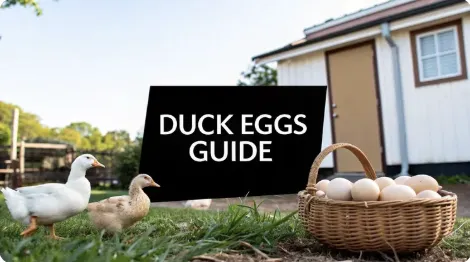
Raising Ducks for Eggs: Essential Guide to a Productive Flock
Raising Ducks for Eggs: Essential Guide to a Productive Flock
Thinking about raising poultry for a steady supply of fresh eggs? While chickens get all the attention, ducks are a fantastic choice, especially if you value rich, delicious eggs perfect for baking. They’re remarkably hardy birds, handle tough weather with ease, and even pull double-duty as pest control for your garden. Raising ducks for eggs is a rewarding way to embrace a little more self-sufficiency while enjoying a daily bounty right from your own backyard.
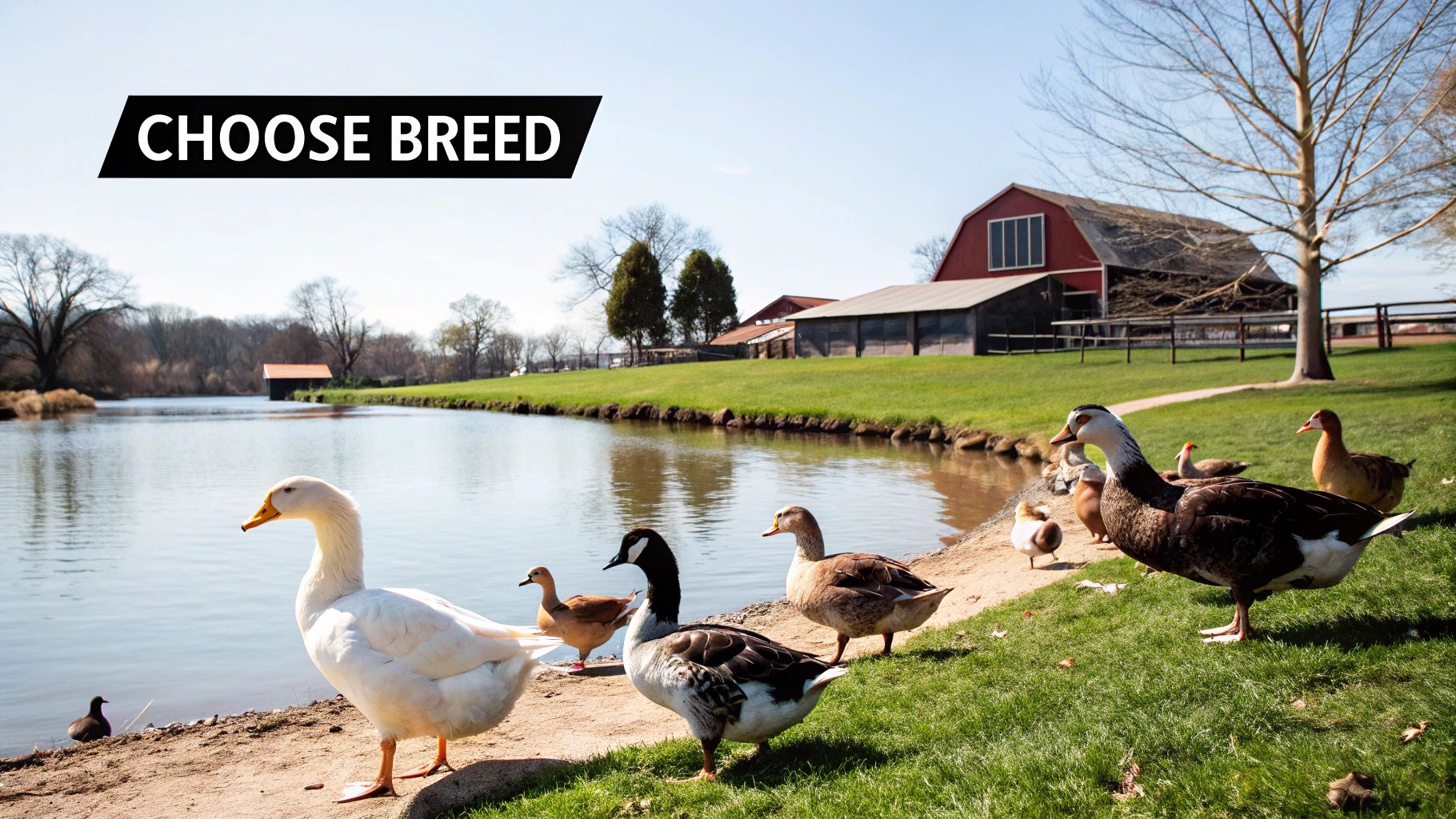
Why Ducks Are an Eggcellent Choice for Homesteads
For homesteaders and backyard farmers, ducks offer a unique and rewarding experience. They're a world away from chickens, bringing a completely different set of benefits to the table that make them a seriously appealing option.
Most people who make the switch to ducks are blown away by just how resilient these birds are. They handle cold, wet weather far better than chickens and will often keep laying consistently through the winter months when chicken production grinds to a halt. That natural hardiness means a lot less fuss for you.
The Superiority of Duck Eggs
Let's be honest, the main reason to raise ducks is for the eggs themselves. Duck eggs are a true culinary delight, prized by bakers and chefs for their incredible properties.
Here’s what makes them a game-changer in the kitchen:
Richer Flavor and Texture: With a much larger yolk-to-white ratio, duck eggs deliver a creamier, richer flavor that takes any dish to the next level.
Nutritional Powerhouse: They pack more protein, omega-3 fatty acids, and essential vitamins like B12 compared to an average chicken egg.
Baking Perfection: The higher fat and protein content is a baker's secret weapon. It creates lighter, fluffier cakes and unbelievably rich custards. I know plenty of bakers who swear they'll never go back.
Deciding which bird is right for your homestead is a big step. If you're still weighing your options, our guide on https://thegroundedhomestead.com/post/raising-chickens-for-eggs is a great resource to compare the two.
Beyond the Egg Basket
The perks of keeping ducks go far beyond their amazing eggs. These birds are multi-talented contributors to a thriving homestead.
Ducks are exceptional foragers, happily gobbling up slugs, snails, and other pests that can destroy a garden. Unlike chickens, they don't scratch up your garden beds, making them the perfect partner in pest control. This foraging instinct also supplements their diet, which can help lower your feed bill.
"Ducks are foraging machines. Our ducks eat far less grain than our chickens, thriving in our forested environment with minimal feed for most of the year."
This guide will walk you through everything you need to know, from picking the best egg-laying breeds to getting their housing set up just right. Get ready to discover why these charming and productive birds might just be the perfect addition to your homestead.
Finding the Right Duck Breed for Your Flock
Choosing the right duck is the very first real decision you'll make when raising a flock for eggs. It's not like picking a paint color; this choice directly impacts your daily chores, how noisy your backyard gets, and, of course, how many eggs you collect each week. Your own setup—whether that's a sprawling homestead or a tidy suburban yard—should be the biggest factor guiding your decision.
I see a lot of first-timers get hung up on egg count alone. While that's obviously important, things like temperament and hardiness are just as crucial if you want this to be a good experience. A super-prolific layer that’s flighty and screams all day might not be the best fit if you’ve got close neighbors or small kids running around.
Top Breeds for Egg Production
When you're talking about consistent, high-yield layers, a few breeds always rise to the top. These ducks have been bred for generations to be egg-laying powerhouses, making them a super reliable choice for anyone serious about a steady supply.
The Khaki Campbell is often called the undisputed champ of egg layers, and for good reason. These birds can pump out over 300 eggs a year. They are active, energetic foragers and are pretty quiet, which makes them a solid, versatile pick for almost any setting. Their eggs are usually a clean white or a light green.
Another fantastic option is the Welsh Harlequin. These ducks are known for their incredibly calm and docile temperament, making them one of the easiest breeds to handle. They're also incredible layers, often producing 250-330 large, white eggs annually. Plus, they're just beautiful birds to watch in the yard.
Dual-Purpose Ducks for Eggs and Meat
If you’re aiming for a flock that does more than just lay, a dual-purpose breed is the way to go. These ducks provide a steady supply of large eggs while also having a heavier build that's suitable for the table. It's an approach that lines up perfectly with a self-sufficient mindset.
The classic Pekin is probably the duck everyone pictures. While they're famous for their meat, they are also very respectable layers, giving you 150-200 extra-large white eggs each year. Their friendly, calm nature makes them a long-time favorite for families.
For a great mix of beauty and utility, you can't go wrong with the Silver Appleyard. This heritage breed is a fantastic forager, a reliable layer of around 200-270 large white eggs a year, and has a stocky build that makes it a superb table bird. They're known for being one of the best all-around homestead ducks out there.
A breed's foraging ability is a huge factor in sustainability. Good foragers can supplement a significant portion of their own diet with pests and plants, which reduces your feed costs and gives you healthier, more nutrient-dense eggs.
To help you sort through the options, I've put together a quick comparison of the most popular egg-laying breeds. This table breaks down the key traits side-by-side, so you can see what might work best for your goals.
Top Duck Breeds for Egg Production Comparison

Choosing a breed isn't just about picking the one with the highest number. A calm, quiet Pekin might be perfect for a family, while an independent, top-tier forager like a Khaki Campbell could be ideal for a larger property where feed costs are a bigger concern.
Factors to Consider Beyond Egg Count
Making the right choice means looking at the whole bird—the complete picture of its characteristics. You need to think about how a particular breed will fit into your property and your lifestyle.
Here are the key traits I always tell people to compare:
Temperament: Do you want a calm, friendly duck like a Welsh Harlequin that your kids can interact with, or are you okay with a more active, independent forager like a Khaki Campbell?
Noise Level: This is a make-or-break factor for anyone in a town or suburb. Muscovy and Welsh Harlequins are exceptionally quiet. Pekins, on the other hand, can be quite vocal.
Climate Resilience: Most ducks are incredibly hardy, but some, like the Pekin, handle cold exceptionally well. Make sure your chosen breed can thrive in your local climate without a lot of extra fuss.
Foraging Skill: If you plan to let your ducks roam, a breed with strong foraging instincts like an Indian Runner or Silver Appleyard will be a huge help with pest control and will need less supplemental feed.
This infographic breaks down some of the key metrics across the top breeds, helping to visualize the real-world benefits of raising ducks for eggs.
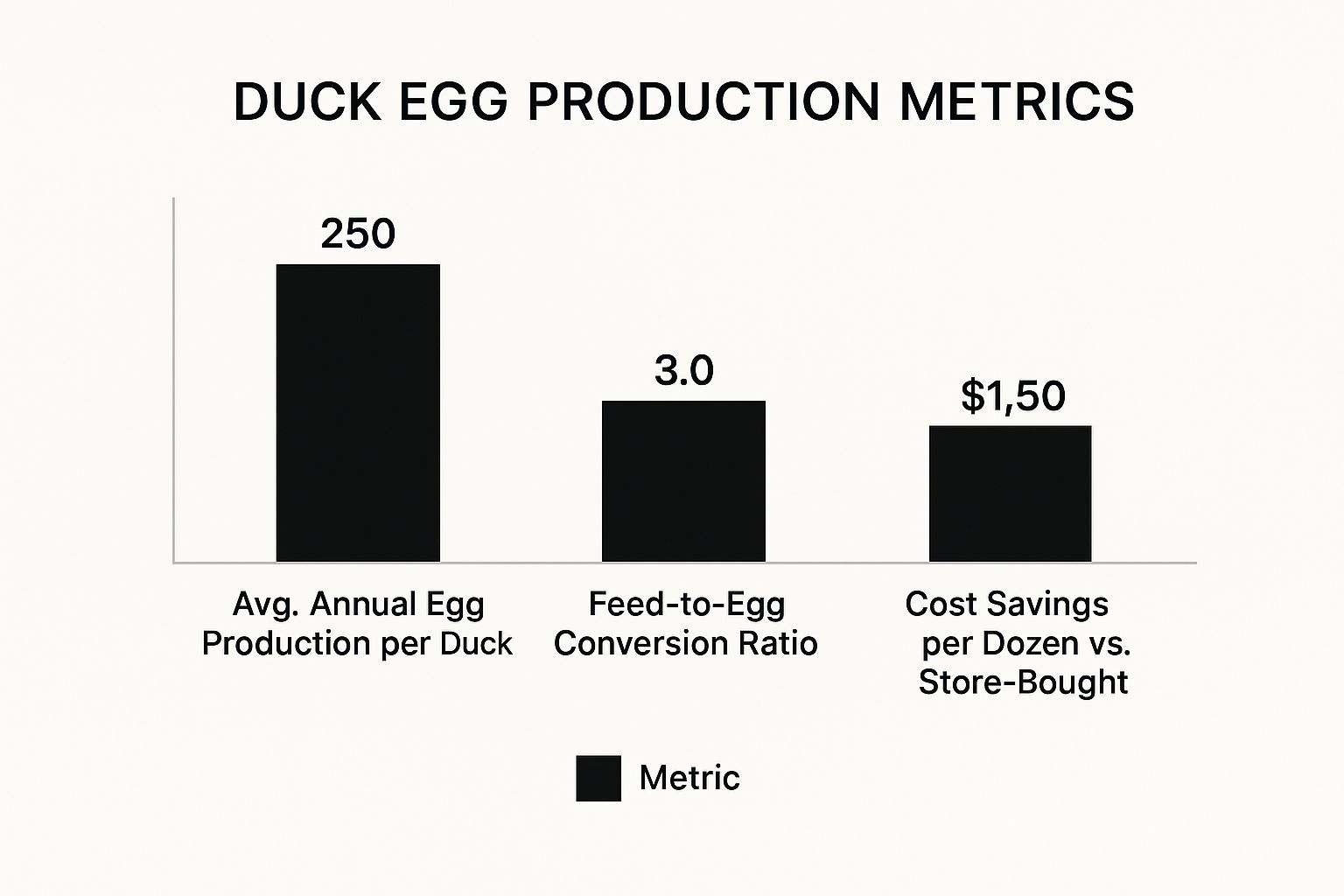
As the data shows, it's not just about the number of eggs. The high-producing breeds also tend to offer a superior feed-to-egg conversion ratio, which really maximizes your savings over time.
Building a Safe and Practical Duck Coop
When you're raising ducks for eggs, a well-built shelter is the cornerstone of a healthy, productive flock. But here’s the thing about ducks: they aren’t chickens. Their housing needs are built around their love of water and the incredible mess they can make. A smart coop design works with these habits, not against them, creating a space that’s safe for the birds and way easier for you to maintain.
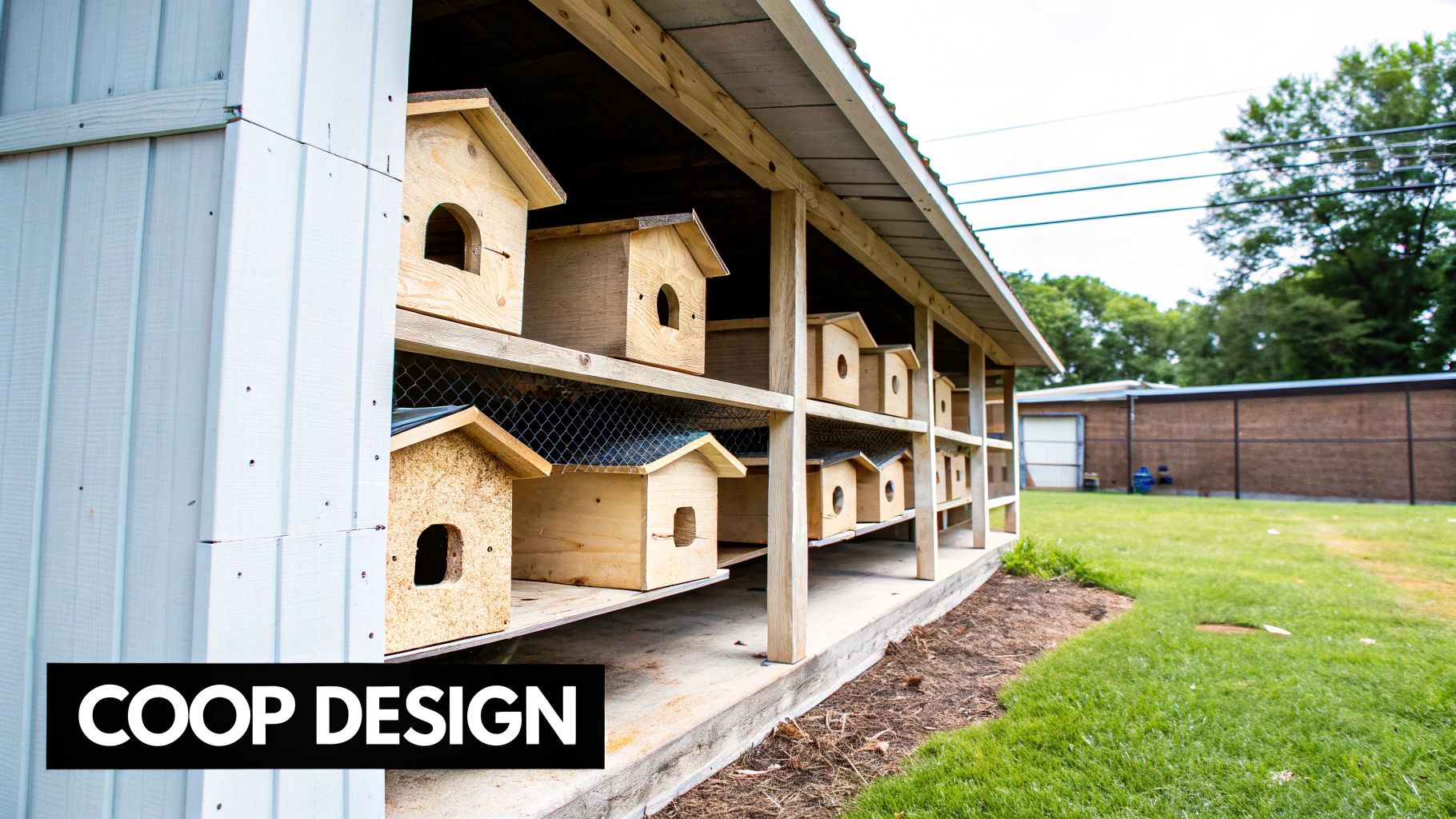
First thing to remember: ducks live on the ground. They don’t need roosting bars like chickens, so forget about those entirely. Your focus should be on secure, clean floor space. I aim for at least 4-6 square feet of coop space per duck. This prevents overcrowding and gives everyone enough room to nestle down comfortably at night.
Designing the Duck House
Ventilation is absolutely non-negotiable in a duck coop. Ducks release a shocking amount of moisture through their breath and droppings, and their wet feathers only add to the humidity. Without proper airflow, that moisture builds up and leads to respiratory issues, frostbite in winter, and a generally miserable environment.
Good ventilation is simple. It just means having openings high up in the coop, well above where the ducks sleep. This lets damp air escape without creating a draft directly on your birds. It's a small design detail that makes a huge difference in keeping the interior dry and the bedding effective for longer.
For the floor, you need to choose materials that can stand up to constant moisture. A simple dirt floor can work if your area is well-drained, but my personal favorite is concrete with a slight slope towards a drain. It’s an investment upfront, but it makes cleaning a breeze. You can also build a raised wood floor, but just know you'll either be replacing it down the line or treating it with a non-toxic sealant.
A classic beginner mistake is using chicken wire for predator-proofing. Raccoons can easily reach right through its wide openings. You must use ½-inch hardware cloth on all windows, vents, and any other openings to create a truly secure barrier.
Bedding and Nesting Areas
Let's be honest, ducks are messy. The right bedding is your best tool for managing their waste and all that moisture. The deep litter method, using a thick layer of pine shavings or straw, works beautifully for ducks. As they add manure and moisture, you just stir the bedding and toss a fresh, dry layer on top. This creates a slow composting action that keeps the coop warmer in winter and drastically reduces how often you need to do a full clean-out.
While ducks aren't picky about fancy nesting boxes, they do appreciate a designated, private area to lay their eggs.
Create Secluded Corners: A simple three-sided box or a corner partitioned off with a board is all they need.
Keep it Low: Make sure any nesting areas are right on the floor level.
Add Deep Bedding: Fill these spots with a generous amount of clean, dry straw. This encourages them to use it and keeps the eggs clean and protected.
The Outdoor Run and Water Access
A secure outdoor run is just as important as the coop itself. This is where your ducks will forage, preen, and splash around safely. The run should provide 10-25 square feet per duck at a minimum. The fencing needs to be at least 3-4 feet high to contain most domestic breeds and buried about a foot deep to stop digging predators like foxes.
Sunlight is vital for ducks—it helps them produce vitamin D and keep their feathers healthy through preening. But they also need a place to escape the intense heat. Make sure the run has a mix of sunny spots and shaded areas, which you can create with a simple tarp, some shrubs, or a well-placed shade tree.
Finally, you have to give them water for swimming. Ducks need to be able to fully submerge their heads to clean their eyes and nostrils. A simple plastic kiddie pool is a perfect, low-cost solution. To manage the muddy mess that will inevitably form around it, place the pool on a bed of gravel or sand to help with drainage. You'll want to change the water every day or two.
A truly safe coop isn't just about keeping predators out; it's also about managing threats from within. You'll want to learn some effective rat prevention strategies to keep your feed stores and your flock safe from these persistent pests.
Mastering Your Flock's Nutritional Needs
A healthy duck is a productive duck, and what you put in their feeder is the foundation of their entire well-being. When you're raising ducks for eggs, their diet has a direct line to everything from the number of eggs you collect to how strong the shells are. Unlike chickens, ducks have a few unique dietary needs that are absolutely critical for them to thrive.
Proper nutrition starts the moment they hatch. Ducklings grow at an incredible rate, and they need a diet that can keep up with their rapid development, especially when it comes to their leg and bone structure.
Fueling Your Ducklings for a Strong Start
The most important nutrient for a young duckling is niacin, also known as vitamin B3. A niacin deficiency is one of the most common—and preventable—health problems I see with new duck owners. It often leads to leg weakness, lameness, and a heartbreaking condition known as "spraddle leg."
Here's the problem: standard chick starter feed just doesn't have enough niacin for ducks. You absolutely have to supplement it.
Brewer's Yeast: This is the easiest and most popular fix. Simply mix nutritional or brewer's yeast into their starter feed. A good rule of thumb is about 1-2 tablespoons per cup of feed.
Liquid Niacin: You can also find liquid B vitamins to add to their drinking water. This is a great backup for ducklings that might not be eating well yet.
High-Niacin Treats: Offering finely chopped green peas or leafy greens gives them a natural boost they'll love.
For their first two weeks, ducklings should be on a starter feed with around 20-22% protein. After that, you can switch them over to a grower feed with about 16-18% protein until they're just about ready to start laying.
Feeding Your Laying Ducks for Peak Production
Once your ducks hit about 16-20 weeks old—or when you find that first thrilling egg—it’s time to switch them to a quality layer feed. This feed is specifically formulated to support their bodies through the daily demands of egg production.
The ideal layer feed for ducks should contain 16-18% protein. This gives them the building blocks for creating eggs without putting extra stress on their system. But protein is only half the story. Calcium is just as vital.
Providing a separate, free-choice source of calcium is non-negotiable. Without it, your ducks will lay soft-shelled eggs and may even leach calcium from their own bones, leading to serious health issues.
Keep a separate dish of crushed oyster shell or crushed eggshells (from your own flock, baked to sterilize them) available 24/7. Your ducks are smart; they will only eat as much as their bodies need to form strong, healthy eggshells. While this section is all about ducks, you can find some great insights into formulating poultry feeds in our guide on how to make chicken feed.
A quick look at the dietary timeline can help keep things straight, from fuzzy ducklings to hardworking layers.
Sample Duck Feeding Guide by Age
This table gives a general overview of a duck's dietary needs as they grow. Always observe your flock and adjust as needed based on their health, breed, and the season.

Remember, this is a starting point. Access to good forage can change their needs, so always keep an eye on your flock's condition.
The Benefits of Foraging and Healthy Treats
One of the best parts about raising ducks is their incredible foraging ability. Letting your flock roam your property (safely, of course) gives them a varied diet of insects, slugs, and fresh greens. This doesn't just cut down on your feed bill; it results in eggs with richer, darker yolks packed with more nutrients.
Supplementing their diet with healthy treats also provides enrichment and boosts their nutritional intake. Ducks go absolutely wild for:
Green Peas: Floating them in a tub of water turns snack time into a fun activity.
Leafy Greens: Chopped lettuce (skip the iceberg), kale, and Swiss chard are all excellent.
Mealworms: A fantastic protein source, especially during their annual molt when they need the extra boost.
Chopped Fruits & Veggies: Berries, melon, and cucumbers are perfect hydrating treats in the summer.
Just as important is knowing what not to feed them. Stay away from processed foods, bread (it has no nutritional value and can cause digestive problems), raw potatoes, onions, or anything that looks moldy.
The global egg industry is massive, producing over 1.3 trillion eggs annually as of 2022. While duck eggs are a smaller slice of the pie compared to the 7.2 billion dozen hen eggs produced in the U.S. each year, their popularity is on the rise as more people discover their amazing taste and nutritional punch. You can find more egg industry statistics on zipdo.co. This growing interest makes understanding their specific dietary needs more important than ever for a successful homestead flock.
Keeping Your Ducks Healthy and Thriving
The simplest path to a vibrant, productive flock is proactive care. When you're raising ducks for eggs, their health directly impacts your breakfast table. A few moments of observation each day can make all the difference, helping you catch potential problems long before they become serious.
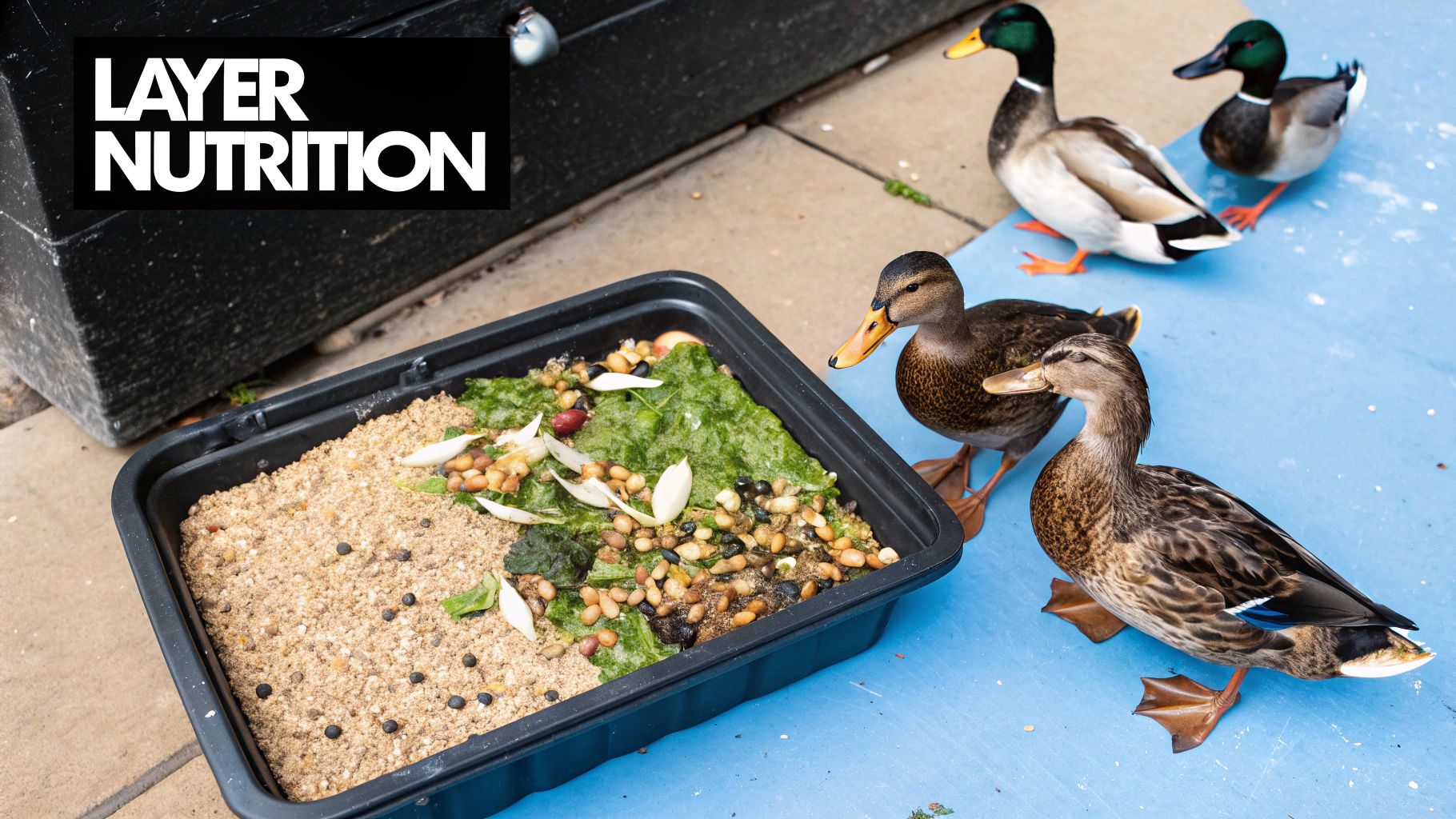
Think of it as your daily "flock wellness check." As you head out to feed them or collect eggs, just watch them for a minute. Are they active and alert? Do they move easily, without a limp? Are their eyes bright and clear? A duck that is lethargic, isolating itself, or has ruffled, unkempt feathers is telling you something is off.
Identifying Common Duck Ailments
Even with the best care, you might run into a health issue now and then. Knowing what to look for is half the battle, allowing you to act quickly before things get out of hand. Two of the most common problems I see in backyard flocks are bumblefoot and wry neck—both are highly treatable if you catch them early.
Bumblefoot is essentially a staph infection of the footpad, often starting from a small cut or scrape. It shows up as a swollen, hot footpad, sometimes with a tell-tale black scab in the center. The usual culprits are rough surfaces, hard landings from heights, or constantly wet, dirty bedding. Treatment involves a good soak, cleaning the wound, and applying an antiseptic.
Wry neck, or torticollis, is a condition where a duck’s head is twisted at an odd angle. It looks alarming, but it's usually caused by a vitamin deficiency (especially Vitamin E and selenium) or a minor head injury. Fixing it often just means supplementing with vitamins and giving some supportive care to make sure the duck can still eat and drink easily.
Practical Biosecurity Measures
Honestly, preventing disease from ever entering your flock is far easier than treating it. This is where biosecurity comes in. It sounds like a complex term, but for a backyard flock, it’s just about simple, common-sense practices.
The single most important rule is to quarantine all new birds. Any duck you bring home, whether from a hatchery or another farm, should be kept completely separate from your existing flock for at least 30 days. This gives you plenty of time to observe them for any signs of illness that could otherwise tear through your flock.
A strong biosecurity plan is your flock's first line of defense. Simple actions like quarantining new arrivals and using dedicated coop footwear significantly reduce the risk of introducing devastating diseases.
Other simple biosecurity steps are just as crucial:
Dedicated Footwear: Have a pair of boots or shoes that you only wear inside the coop and run. This stops you from tracking in contaminants from the outside world.
Pest Control: Stay on top of managing rodents and wild birds. They can be carriers of diseases and parasites you definitely don't want.
Cleanliness: Regularly scrub feeders and waterers. It’s a small chore that prevents the buildup of harmful bacteria.
Preventing Parasites
Parasites, both internal and external, can drain a duck of its energy and health, leading to a sharp drop in egg production. A preventative approach here keeps your flock comfortable and thriving.
External parasites like mites and lice can be a real nuisance, especially in warmer months. They hide in bedding and on the birds themselves, causing irritation and feather loss. An easy fix is providing a dust bath area with wood ash or food-grade diatomaceous earth—this lets the ducks manage these pests themselves.
Internal worms are trickier to spot. The signs might be subtle, like weight loss, diarrhea, or just a general poor condition. Some folks use a dewormer preventatively once or twice a year. Others prefer to have a fecal test done by a vet to confirm there's an issue before treating. Natural preventatives, like adding pumpkin seeds or garlic to their diet, are also popular practices.
The health of your flock is a direct reflection of their environment and care. In Taiwan, a region with a long history of duck consumption, shifts in farming practices have impacted flock sizes over the years. Data shows that the number of duck farms decreased from 446 in 2014 to 369 in 2023, with corresponding changes in the total duck population. You can explore more about these duck farming industry trends to understand large-scale flock management. These proactive health strategies ensure your small-scale flock remains robust and productive.
A Guide to Collecting and Storing Duck Eggs
The best part of raising ducks is finally here—gathering a daily basket of those rich, delicious eggs. To make the most of your efforts, it helps to understand a duck's natural rhythm. Most ducks lay their eggs very early in the morning, often before the sun is even up, so a morning collection routine is your best bet.
Unlike chickens, ducks aren't too fussy about fancy nesting boxes, but they do prefer quiet, secluded spots. You might find eggs in a corner of the coop or even tucked away under a bush in their run. You can gently nudge them to lay inside by providing clean, deep straw bedding in sheltered corners. This keeps the eggs cleaner and a whole lot safer.
Cleaning and Storing for Freshness
When you gather your eggs, you’ll notice they have a natural protective coating called the bloom. This invisible layer is nature's perfect preservation system—it seals the shell's pores, keeping bacteria out and moisture in.
Because of this, you should avoid washing your eggs unless they're really soiled. A quick wipe with a dry brush or cloth is usually all it takes to remove light debris. Unwashed eggs with their bloom intact can safely be stored right on your counter for several weeks.
Keep the bloom on for as long as possible. An unwashed duck egg, thanks to its thicker shell and protective bloom, can last for a month or more at room temperature, far outlasting a typical chicken egg.
If an egg is just too dirty to be dry-cleaned, wash it with warm water (always a bit warmer than the egg itself) right before you plan to use it. Washing strips away the bloom, so any washed eggs must be refrigerated immediately and used within a few weeks. Storing them pointed-end down in a carton helps keep the yolk centered and fresh.
If you're interested in keeping your harvest for even longer, you can learn about how to preserve eggs without refrigeration in our detailed guide.
Duck eggs truly are a culinary treasure. Their large, rich yolks are a baker's secret weapon, creating incredibly moist cakes and creamy custards. And trust me, they also make the most amazing fried eggs you've ever had.
Common Questions About Raising Ducks
Once you decide to bring ducks home, a few practical questions always pop up. It's totally normal. Getting these sorted out from the start will give you the confidence that you're setting your flock up for a great life. Let's tackle the big ones I hear all the time from new duck keepers.
Do I Need a Drake for Eggs?
This is easily the most common misconception out there. The short answer is no. Your female ducks will lay beautiful eggs consistently whether a male, or drake, is around or not. You only need a drake if you want those eggs to be fertile for hatching your own ducklings.
Honestly, for a flock that's purely for egg-laying, I almost always recommend sticking with all females. An all-hen flock is typically quieter and you get to skip the potential drama and aggression drakes can sometimes bring to the party.
Can Ducks and Chickens Live Together?
While you can technically keep ducks and chickens in the same space, I generally advise against it, especially if you're just starting out. Their daily needs are just too different. Ducks are water birds through and through—they're messy, they splash everywhere, and they turn dry ground into a mud pit in minutes.
While mixed flocks can work with careful management, separating them is usually the simplest route to a healthy environment for both species. The high moisture from ducks can compromise the dry conditions that chickens need to thrive.
That constant dampness is a recipe for respiratory problems in chickens, who need a dry environment to stay healthy. If you absolutely have to house them together, you’ll need a huge, exceptionally well-ventilated coop with designated dry zones for the chickens and completely separate areas for their food and water to keep the peace and the mess contained.
How Long Do Ducks Lay Eggs?
Most of the popular domestic duck breeds are fantastic layers for about 3 to 5 years. You'll see their best work in their first two laying seasons, and after that, production will taper off a bit each year.
But here’s the great part about ducks: they have a much longer lifespan than chickens, often living for 8 to 12 years with good care. Even when they're past their peak laying years, they are still incredible foragers, fantastic pest control for the garden, and just a joy to have around. Their contribution to your homestead lasts long after the daily egg-laying slows down.
Ready to dive deeper into creating a thriving homestead? The Grounded Homestead offers practical guides and insights to help you grow your own food and live more sustainably. Explore more at https://thegroundedhomestead.com.


Facebook
Instagram
X
Youtube